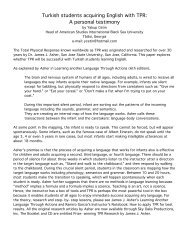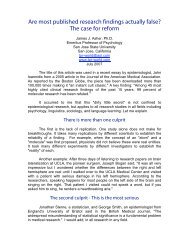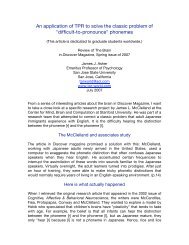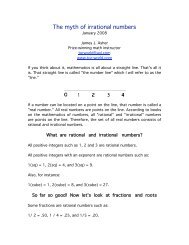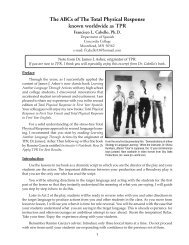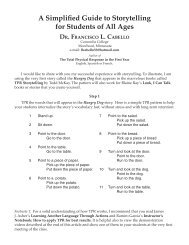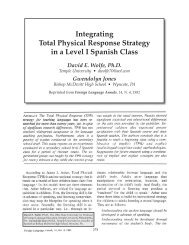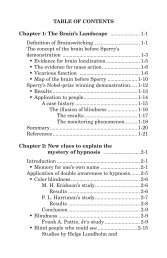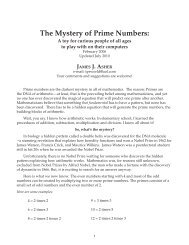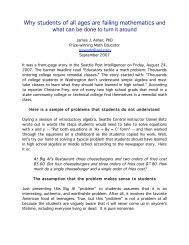A language classroom that works for high-speed learning - TPR World
A language classroom that works for high-speed learning - TPR World
A language classroom that works for high-speed learning - TPR World
Create successful ePaper yourself
Turn your PDF publications into a flip-book with our unique Google optimized e-Paper software.
The left brain encourages students not to take risks<br />
The left brain does not want the student to take risks because the person may make a mistake. The<br />
right brain, <strong>for</strong> comparison, encourages playfulness without fear. The right brain tells the student:<br />
“Take a chance! You won’t go to jail! Enjoy it! Just start doodling in this new <strong>language</strong>.”<br />
Translating into one’s native <strong>language</strong><br />
Translation from one <strong>language</strong> into another <strong>language</strong> is a harmful left brain approach because it<br />
slows down communication. If you think about it, translation is abnormal in <strong>high</strong>-<strong>speed</strong><br />
communication between fluent speakers. To memorize the pronunciation of a new <strong>language</strong> and<br />
decipher the meaning in another <strong>language</strong> are extra steps <strong>that</strong> are totally unnecessary when one<br />
acquires the second <strong>language</strong> without reference to one’s native <strong>language</strong>.<br />
The research shows <strong>that</strong> these left brain procedures do not work <strong>for</strong> most students:<br />
“Listen and repeat after me!”<br />
“Analyze this sentence.”<br />
“Translate this paragraph,” and<br />
“Memorize this dialogue.”<br />
By most students we mean most students in the introductory and even intermediate levels.<br />
Advanced students may very well find many of these left brain techniques to be useful to fine-tune<br />
their skills in the second <strong>language</strong>.<br />
Well, then—what does work <strong>for</strong> most students in the beginning and intermediate levels?<br />
Brain organization and <strong>language</strong> acquisition<br />
Since Roger Sperry’s Nobel Prize winning experiment showing <strong>that</strong> each hemisphere of the brain<br />
can think independently, more than 4,000 studies of brain lateralization have been conducted<br />
worldwide. In the past 30 years, we learned more about how the brain is organized than we knew in<br />
the prior 3,000 years. Here is what we now know:<br />
Comprehension comes be<strong>for</strong>e speaking<br />
Asher (2003) has demonstrated in decades of experiments <strong>that</strong> the optimal <strong>language</strong> acquisition<br />
experience is: comprehension be<strong>for</strong>e speaking. You can observe this yourself with babies. For<br />
months be<strong>for</strong>e even babbling appears, there is a silent period in which the infant seems to be<br />
listening to directions from caretakers: “Look at me!” “Smile <strong>for</strong> Daddy!” “Raise your hand!” “Walk to<br />
Mommy!” These are unique “conversations” in which someone speaks and the child responds with a<br />
physical action. I call this the “total physical response” which is known worldwide as <strong>TPR</strong>.




